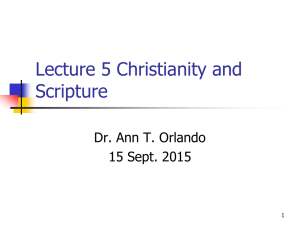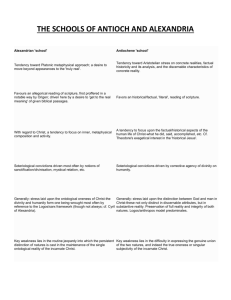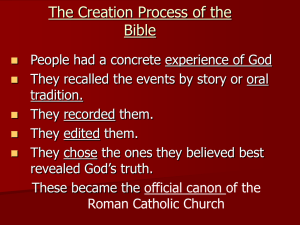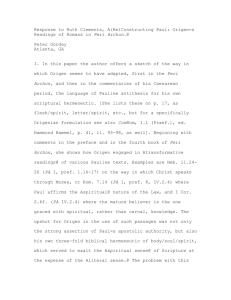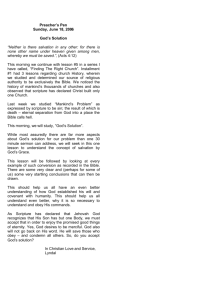I want to begin by thanking Prof. Clements and Prof.... helped me understand Origen better and stimulated my thinking immensely.... Response to
advertisement
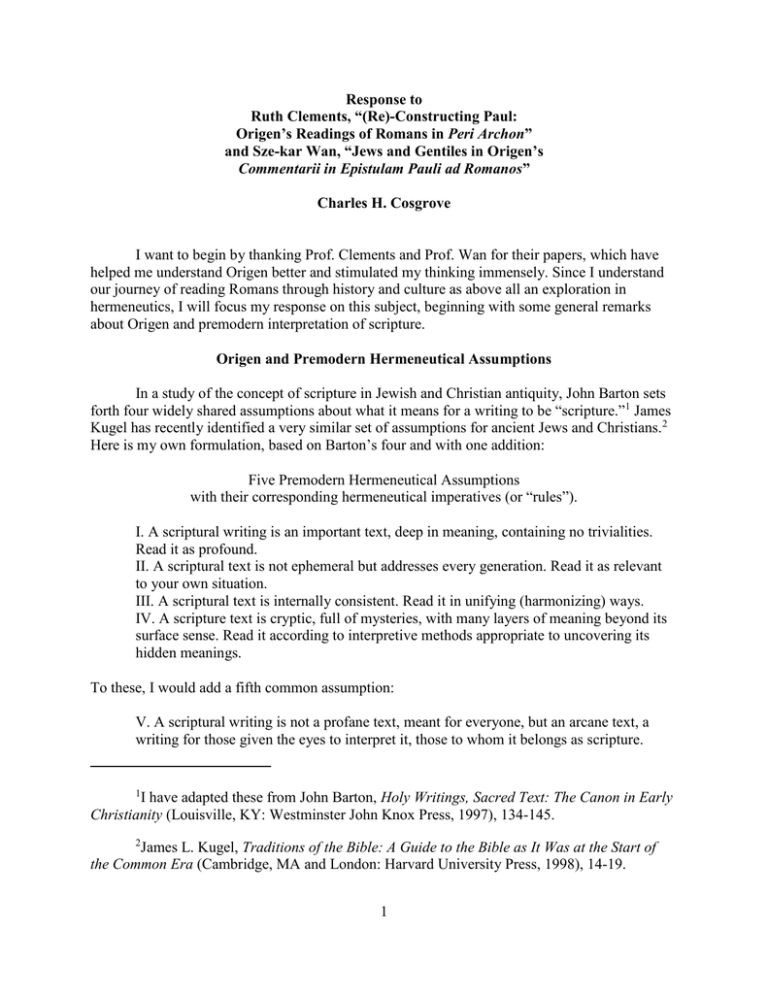
Response to Ruth Clements, “(Re)-Constructing Paul: Origen’s Readings of Romans in Peri Archon” and Sze-kar Wan, “Jews and Gentiles in Origen’s Commentarii in Epistulam Pauli ad Romanos” Charles H. Cosgrove I want to begin by thanking Prof. Clements and Prof. Wan for their papers, which have helped me understand Origen better and stimulated my thinking immensely. Since I understand our journey of reading Romans through history and culture as above all an exploration in hermeneutics, I will focus my response on this subject, beginning with some general remarks about Origen and premodern interpretation of scripture. Origen and Premodern Hermeneutical Assumptions In a study of the concept of scripture in Jewish and Christian antiquity, John Barton sets forth four widely shared assumptions about what it means for a writing to be “scripture.”1 James Kugel has recently identified a very similar set of assumptions for ancient Jews and Christians. 2 Here is my own formulation, based on Barton’s four and with one addition: Five Premodern Hermeneutical Assumptions with their corresponding hermeneutical imperatives (or “rules”). I. A scriptural writing is an important text, deep in meaning, containing no trivialities. Read it as profound. II. A scriptural text is not ephemeral but addresses every generation. Read it as relevant to your own situation. III. A scriptural text is internally consistent. Read it in unifying (harmonizing) ways. IV. A scripture text is cryptic, full of mysteries, with many layers of meaning beyond its surface sense. Read it according to interpretive methods appropriate to uncovering its hidden meanings. To these, I would add a fifth common assumption: V. A scriptural writing is not a profane text, meant for everyone, but an arcane text, a writing for those given the eyes to interpret it, those to whom it belongs as scripture. 1 I have adapted these from John Barton, Holy Writings, Sacred Text: The Canon in Early Christianity (Louisville, KY: Westminster John Knox Press, 1997), 134-145. 2 James L. Kugel, Traditions of the Bible: A Guide to the Bible as It Was at the Start of the Common Era (Cambridge, MA and London: Harvard University Press, 1998), 14-19. 1 Read it from the circle of insiders. (If scripture is also for outsiders, they are dependant on insiders.) Prof. Clements identifies various passages in Paul’s letters that Origen treats as hermeneutical keys. It is illuminating to ask how far Origen’s hermeneutical principles correspond to the widely shared assumptions I have just listed. The following list, based on Prof. Clements’ paper, summarizes Origen’s hermeneutical principles and correlates them with the Five Premodern Hermeneutical Assumptions: Origen’s Hermeneutical Principles 1. Scripture is written “for our sake,” that is, for us who have the spiritual keys to understand it. (1 Cor. 10:11) This correlates with II but qualifies it. If scripture is written for us, it remains relevant to us generation after generation. Does this principle of relevance apply also for the generations of Israel before the revelation of Christ (according to Origen or the historical Paul)? This also correlates with V. spiritual Christians are the insiders who possess the keys to correct understanding. Jews and others are outside this circle. Simple Christians and heretics are also largely outside. 2. Scripture has a hidden spiritual sense, beyond its literal (“bodily”) meaning, that must be interpreted spiritually (figuratively, allegorically). In Origen this is variously described. The Law/Old Testament is “copy” of heavenly things and “shadow of things to come;” it must be interpreted figuratively (based on Heb. 8:5 and Col. 2:16-17). To understand the Law means not observing its literal requirements but comprehending the allegories in what is written (based on Gal. 4:21-24). The whole Law is spiritual, containing spiritual meaning that only the few can grasp (based on Rom. 7:14). All of this correlates with IV. 3. Clinging to the literal sense apart from or against its spiritual sense distorts the literal sense (which is to lead to the spiritual). The letter thus distorted “kills.” (based on 2 Cor. 3:6) This assumes IV and works out one of the relations, as Origen sees it, between the patent and the hidden meaning of scripture. 4. God has placed skandala in the literal sense as signs that scripture is not to be read only at the literal level (and that some passages have no viable literal sense). 2 This principle depends on II. and III. 5. Jews are the hermeneuts of literalist interpretation; Christians are the hermeneuts of spiritual interpretation, which gives proper place to the bodily, soulish, and spiritual senses of scripture. Some carnal or heretical Christians are also literalists. Some Jewish scholars are very helpful guides to the bodily meaning of scripture and also to the soulish (moral) sense. The hermeneutical principle here is that proper interpretation of scripture depends not only on hermeneutical theory, in an abstract sense, but also crucially on the identity and character of the interpreter. Being part of the community of Christ and being a spiritual person are necessary (if not sufficient) conditions for understanding scripture fully and truly. This correlates with V and works out a subordinationist dichotomy within the circle of insider hermeneuts. In some sense Jews are insiders–the scriptures were written for theme. But they are not insiders in the fullest sense. Moreover, their hermeneutical vantage point is subordinate to the superior hermeneutical position of the church. Modern(ist) Hermeneutical Principles in Churchly Interpretation of the Bible Modern historical-critical scholarship, including churchly historical-critical scholarship, has for the most part rejected premodern hermeneutics. Historical scholarship has affirmed a set of counter- principles, a hermeneutics that challenges the Five Premodern Assumptions. Here are my formulations of these modern hermeneutical principles with some observations suggesting that there may, in fact, be less distance between modern churchly historical scholarship and premodern exegesis than one commonly assumes (an observation that others have also made in recent years). Five Modern(ist) Hermeneutical Principles Im. A scriptural writing is a writing like any other, which may contain profundity and triviality, along with everything in between. Read scripture “like any other book.” In practice, most churchly historical critics have operated with a presumption of signific ance and have 3 looked for signific ance and profun dity. IIm. A scriptural text is a historically contingent writing, dependant for its meaning on its original setting, applying directly only to its original hearers, and relevant (if at all) only indirectly and analogically to later generations. Read scripture for its original meaning and honor that original meaning in making any analogical connections with your own time and place. In practice, this has often cast the churchly historical critic in the role of umpire, declaring some churchly interpretations “safe” and others “out.”3 The base runners in this game have often ignored (and resented) these self-appointed referees. IIIm. A scriptural text is as likely as any other writing to display both internal consistency and internal contradiction and disjointedness. Read scripture without harmonizing. In practice, reading scripture without harmonizing is part of the churchly scholar’s strategy for dismantling the quasi-premodern approaches to scripture that students bring to college, university, and seminary. It is also one of the ways that churchly scholars find hidden meanings in biblical texts, but here “hidden” refers to earlier layers of the tradition. IVm. A scriptural text communicates in ordinary ways, by the logic of conventional language and the common genres of its original socio-linguistic contexts. Read scripture like you would any other book. In fact, churchly historical critics don’t usually read scripture (only) like any other book. Consider how they have typically interpreted Genesis 1. The critical commentaries are not interested in exploring the facticity of the story of creation, the degree of correspondence (if any) between the literal meaning of the text and a I owe this figure to Wayne Meeks, “On Trusting an Unpredictable God: A Hermeneutical Meditation on Romans 9-11,” in Faith and History: Essays in Honor of Paul W. Meyer, ed. John T. Carroll, Charles H. Cosgrove E. Elizabeth Johnson (Atlanta: scholars Press, 1990). Meeks suggests that historical criticism should give up its role as “umpire,” acknowledge that ahistorical “charismatic” readings have their place, and adopt a position of “standing up for the past” in the dialogue between the pastness and presentness of the text. 3 4 referential external world or set of actions. Nor is the churchly critical commentator interested primarily in the literal meaning in itself (as a literary sense). As James Barr has observed, the literal level of the story is important because it provides clues to the theology of the story. Barr suggests that this makes churchly critical scholarship closer to allegorical exegesis than to literalist or historical exegesis.4 I agree, especially, where the theological meaning of the text is set forth with the help of traditional Christian concepts. Something quite akin to Origen’s notion of the bodily and soulish/spiritual senses of the text is in evidence here. Taken literally, the creation account presents a skandalon for the modern interpreter. But we don’t reject the literal level. We do justice to the “letter” by pressing on to the theological intent, which is more than and other than the letter, although it can be discovered only through the “letter.”5 Vm. A scriptural writing is open to correct interpretation by anyone (regardless of their spiritual or religious identity) who knows the original languages of the Bible and can read the Bible in its (reconstructed) ancient historical setting. Read scripture from the historically reconstructed vantage of ancient readers. Practically speaking, this has meant–and generations have seminary students have experienced it as–a privileging of the scholarly guild of biblical interpreters as the insiders who possess the keys to interpretation. The rest of the church is a bit like the simple Christians in Origen’s construction–both insiders and outsiders, able to interpret at a rudimentary level but certainly subordinate in status as hermeneuts. Origen’s Spiritual Hermeneutic Prof. Clements makes the astute comment that Origen’s use of Paul to develop a distinctively Christian hermeneutic is revealing not only for what Origen draws on in Paul but also for what he passes over (or so radically reinterprets as to practically suppress) (Clements, 2). James Barr, “The Literal, the Allegorical, and Modern Scholarship,” Journal for the Study of the Old Testament 44 (1989): 12-13. 4 By “letter” I have in view the original, literal sense that ancient readers would have found in the story. They would have assumed that the text is talking about what God factually did. They would not have raised our scientific questions as a point of skandalon but some of them, such as Origen, did discover problems at the literal level of purported facticity. These skandala, Origen says, are reminders that the text has other, non-literal meanings. 5 We sometimes use the term “myth” in a positive sense to describe a text that lets itself be interpreted beyond the letter in ways that are significant, even profound, not only for ancient people but for us, too. 5 Examples are Rom. 1:17 (the priority of the Jew), 3:2 (“they have been entrusted with the oracles of God”), and 11:1-2, 26-28 (God “has not rejected his people,” the Jews, but will save “all Israel” in faithfulness to the irrevocable promises made to the Jewish people). Origen’s “transformative” exegesis (Clements p. 2), it seems, distorts the historical Paul. I agree that much of what Origen does with Paul’s teaching about Israel exceeds the bounds of what today counts as reasonable historical-critical interpretation. But there is more than one reasonable way to read Paul historically and some of Origen’s anti-Jewish interpretations are not too far from some historically defensible ways of interpreting Romans. Some very able Pauline scholars continue to argue the traditional view that in Paul’s understanding the new people of God (the church of Jews and gentiles) supersedes ethnic Israel and in effect becomes the new Israel. This line of exegesis goes against the grain of another emergent scholarly view that the Jews remain God’s people Israel, post Christum, and continue to have their own, valid way from God (a Sonderweg) alongside the way of Christ for the church. I don’t think the debate over these two readings of (true) Israel in Paul can be settled exegetically. Romans is susceptible to more than one reasonable historical-critical interpretation.6 I will come back to this after looking at an ostensibly hermeneutical statement in Romans that Origen does not take hermeneutically. I have in mind Rom. 3:19: “We know that whatever the law says it says to those under the law.” The context is Paul’s quotation of a string of denunciations taken most from the Psalms (Rom. 3:10-17). These show that all are under sin, Jews and gentiles. If the law speaks here as the Psalms and some of the prophets, then Paul is using the term “law” (nomos) in the sense of scripture (a common way of speaking about scripture in his day). I paraphrase Paul’s hermeneutical principle as follows: “Whatever scripture says it says to those under the authority of scripture.” As it happens, the passages Paul quotes are, in their original contexts, denunciations of gentiles, not Jews. Paul invokes his hermeneutical principle to justify applying these words of scripture to Jews as well. Origen does not interpret “law” in this passage as scripture. He argues that law must mean “natural law,” since only natural law applies to both Jews and gentiles. Why? Is it because he cannot accept the claim that everything the law as scripture says applies to those under the law? I find some support for this conjecture in Prof. Clements’ observation that, for Origen, the promises in scripture were never meant for Jews but were always meant for Christians (Clements, 18).7 On the other hand, I can imagine ways in which Origen might have construed nomos as scripture in Rom. 3:19 and still have worked out an interpretation that preserves the hermeneutic by which he effectively reads the Jewish people out of the promises and denies them identity as 6 On the question of the Sonderweg for Israel and how the church should deal with competing plausible interpretations, see Cosgrove, “Advocating One Reasonable Interpretation of Paul against Other Reasonable Interpretations: A Theological Approach to the Sonderweg Question,” in Another Way? Pauline Soteriology for Jews and Gentiles in Romans, ed. Robert Gagnon (Grand Rapids, MI: Wm. B. Eerdmans, forthcoming). 7 Perhaps Origen was not consistent on this point. As Prof. Wan points out, when Origen treats Rom. 11:25ff. he speaks of the promises being for Israel (Wan, 13). 6 God’s people. His reading of scripture depends on a set of theological convictions that he claims to find in scripture but finds there with the help of those same convictions. Moreover, the theological convictions include his hermeneutic, as Prof. Clements shows (especially with reference to Origen’s interpretation of 1 Cor. 10:18; Clements, 18-19). Origen’s theological opposition between fleshly Jews and spiritual Christians is part of what we might call “the rule of faith” as he understands it, at once a doctrinal and a hermeneutical guide. Prof. Clements observes that for Origen, the spiritual sense of scripture, is primarily about “the doctrines about God and his only-begotten Son.”8 A superficial reading of Origen might give the impression that, in his hermeneutic, allegorical exegesis is the only avenue to discovering these doctrines. But by his own claim, he already knows these doctrines from the apostolic teaching of the church, especially in the Gospels and Paul.9 His allegorical exegesis is the way in which he discovers Christian doctrine in those parts of scripture where it is not express, but hidden (especially in the Old Testament).10 Thus, the content of the spiritual teaching exists, for Origen, at a plain sense level in at least some parts of the apostolic writings. Prof. Wan puts his finger on the crucial point, when he observes that for Origen allegorical interpretation is christological interpretation (Wan, 9). This insight deserves further exploration. As far as I can see, Origen invokes the plain sense of express christological statements in the New Testament as revelation of spiritual doctrines. In the express christological statements of the New Testament, the “plain sense” is the “literal sense,” if by literal one means the conventional grammatical (not a “bodily”) sense. This plain/literal sense is the spiritual sense. Origen’s interpretation of Rom. 9:5 is a good example of this.11 Following a grammatical construal that takes the phrase ho n epi pant n theos eulog tos eis tous ai nas as an appositional statement modifying “Christos” and thus clearly asserting Christ’s identity as God. Origen does not distinguish the plain sense literal meaning here from a hidden spiritual meaning. The reason is that in this case the plain sense is the unveiled spiritual meaning that in turn becomes the hermeneutical key to spiritual interpretation of the Old Testament. How far the New Testament speaks spiritually in its plain/literal sense for Origen is a topic worth exploring. If a christological rule of faith guides Origen’s spiritual exegesis, do any other convictions or sensibilities inform his hermeneutical judgments? If I read them rightly, both Prof. Clements and Prof. Wan are suggesting that it is not antisemitism, born of conflicts with and 8 Clements quotes this phrase from Peri Archon IV.2.7 (Clements, 11). 9 Clements does not emphasize this point, but it is implied by her discussion on pp. 5-6. 10 Allegorical exegesis probably also serves as a kind of dialogue with scripture by which Origen works out his own distinctive understanding of the apostolic doctrines. If he finds there what he is looking for, this may not be too much different than the brilliant way in which Kojève found his own philosophy in (by commenting on) Hegel. Even if the historical Hegel is distorted in Kojève’s reading, Hegel the text was somehow indispensable to the philosophical discoveries Kojève made. 11 Origenes Commentarii in Epistulam ad Romanos, vol. 4, ed. Theresia Heither (Freiburg: Herder, 1994), 140-141. 7 personal animosity toward Jews, that leads to Origen’s anti-Jewish exegesis. It is rather the logic of his theology that leads to anti-Jewish interpretations, a theology that he inherits from and shares with many other early Christian thinkers. This is a significant judgment. I read its implications as follows. It is important to distinguish the political meaning of theological antiJudaism in Origen (and his time) from theological and cultural anti-Judaisn (cum antisemitism) in the modern era, where Christian ethnocentrism acquires racist freight. We can make this distinction without “excusing” Origen’s statements about Jews and Judaism.. I assume that all interpreters are guided by many convictions that are not expressly theological but shape their theological judgments. Sometimes we acknowledge these convictions; often we don’t. Much of the time, we are not fully aware of them. The deepest of these convictions function as “rules of recognition” for judging what we can accept as true or divine, including which interpretations we are ready to accept as valid for faith and practice. It would be a difficult but enormously instructive project to identify the rules of recognition in Origen that do not belong expressly to his rule of faith (but no doubt shape it). Let me illustrate what I have in mind with one example. Prof. Clements notes that Origen defends his interpretation of true circumcision in Rom. 2:28-29 and Phil. 3:2-3 by describing it as dignius. I am not sure how much freight to pack into this translation term, but it strikes me that it implies a kind of “rule of recognition” for what counts as a valid interpretation of scripture. We might formulate it this way: A scriptural writing is a good and virtuous text, teaching nothing undignified or dishonorable. We should read it for virtuous meaning. What counts as “dignity” for Origen? Clearly, however we might define it precisely (if it can be precisely defined), it is part of the cultural knowledge that he takes for granted as manifestly true. In the same way that we “know” that torture is cruel and therefore immoral (people in Origen’s time would not have understood this conviction of ours), so Origen “knows” that bodily circumcision is shameful.. It is not only Origen who brings a sense of what is morally good to the process of discriminating being interpretations of an authoritative text. We all do, and today some advocate that we should, that is, that moral-theological criteria ought to guide churchly adjudications between competing interpretations of scripture.12 Parallel views can be found in contemporary jurisprudence, particularly in the area of constitutional law. Two contemporary examples come to my mind--one from law and the other from theology. Both are especially apropros our reading of Origen. The legal example is the late Justice William Brennan’s claim that the Supreme Court should treat the U.S. Constitution as a document designed to promote human dignity and should read it accordingly.13 Brennan’s notion of dignity as a substantive hermeneutical norm is not the 12 See Daniel Patte, Discipleship according to the Sermon on the Mount: Four Legitimate Readings, Four Plausible Views of Discipleship, and Their Relative Values (Valley Forge, PA: Trinity Press International, 1996); Charles Cosgrove, Elusive Israel: The Puzzle of Election in Romans (Louisville, KY: Westminster John Knox, 1997); idem, “Advocating One Reasonable Interpretation of Paul against Other Reasonable Interpretations;” Robert C. Tannehill, “Freedom and Responsibility in Scripture Interpretation, with Application to Luke,” In Literary Studies in Luke-Acts, ed. Richard P. Thompson and Thomas E. Philips, 265-78 (Macon GA: Mercer University Press, 1998). 13 William J. Brennan, Jr., “The Constitution of the United states: Contemporary 8 same as Origen’s notion of dignitas, but both are operating with their own best sense of what their culture (or subculture) esteems as human dignity and using that sense to adjudicate between competing interpretations of authoritative texts. My other example is the argument by Pauline scholar Lloyd Gaston that if a Judaism-affirming interpretation of Paul is possible, then it is also necessary, after Auschwitz.14 Gaston does not say but his argument implies for me that the “rule of faith” by which the church reads Paul and makes judgments between competing possible interpretations ought to include the conviction that the Jewish people are and remain Israel post Christum and that their way in the Torah is God’s good and life-giving way for them. Auschwitz as history and symbol creates for Gaston and many others of us a kind of “rule of recognition” for judging theology and discriminating between competing interpretations of scripture. Will the Real Paul Please Stand Up! There is a famous scene in the film Annie Hall, where the character played by Woody Allen, playing is with Annie in line at a movie theater. Behind them a man is pontificating on film criticism and modern media theory. Allen fumes in irritation and finally steps out of character when the man begins invoking Marshall McLuhan. At this point Allen steps over to a poster and pulls from behind it the real Marshall McLuhan who proceeds to tell the annoying man, “You know nothing of my work. . . .” Many modern interpreters reading Origen would like to summon the real Paul into Origen’s text to tell Origen, “You know nothing of my work. You have completely misunderstood me.” Prof. Wan’s reference to “what modern critics would call wild allegorization” in Origen’s reading of Paul (Wan, p. 1) and Prof. Clements’ comment that Origen’s “synthetic reading of Paul. . . succeeds “beyond Paul’s intention”15 are reminders that it is almost impossible today to speak about the way premodern interpreters read Paul without assuming that the real Paul is the historical Paul (in the modern sense of that term) and that “we” have a pretty sure grasp on that historical Paul. My guess, however, is that if Origen were with us today, he would like to step into the hallway and bring in the real Paul to tell us moderns (present company excluded) that we know nothing about how to read scripture and for that reason know nothing about how to read Paul. I should stress that neither Prof. Wan nor Prof. Clements uses the term “real Paul.” But both do seem to operate with a distinction between the historical Paul and Origen’s Paul, which may or may not be the same thing as a distinction between “the real Paul” and other Pauls. In any case, Origen would see the way we differentiate between his Paul and ours as a disagreement over who has a better way of getting at the real or true Paul. That Paul, for Origen, includes but is more than the historical Paul’s “intentions” in his letters. For Origen, the real Paul is what Ratification,” in Interpreting the Constitution: The Debate over Original Intent, ed. Jack N. Rakove (1990). I give a brief discussion of Brennan’s view of Constitutional interpretation in Cosgrove, :The Declaration of Independence in Constitutional Interpretation: A Selective History and Analysis,” University of Richmond Law Review 32 (1998): 142. Lloyd Gaston, “Paul and the Torah,” in Antisemitism and the Foundations of Christianity, ed. Alan T. Davies (New York: Paulist Press, 1979), 67. 14 15 Clements, 28. 9 Paul’s letters say as scripture revealing the intentions of the Logos, the divine Author. Since Origen is not here to defend himself and Paul is not likely to descend from heaven to instruct us, I’m going conclude by giving a short little speech in the name of Origen about how to read Paul. And, so as not to give offense, I’m going to address this speech to an anonymous New Testament scholar, whom I’ll call Professor Hans Bibfeldt:16 Professor Bibfeldt, your business card describes you as a Professor of New Testament Studies, but as far as I can tell, you don’t make the theological concept of a “New Testament” determinative for how you read the New Testament or the rest of scripture. You claim to recover the real historical Paul and often appeal to him as an authoritative voice of the church’s scriptures, a corrector of bad popular theology. Well and good, but how can you claim to be a faithful interpreter of Paul and invoke Paul for your own theology when you don’t read scripture the way Paul read scripture? How can you appeal to Paul’s letters as scripture when you don’t read those letters the way they read scripture? Why don’t you read scripture christologically? Are you deaf to Paul? And why do you think the burden of proof is on me to prove that I’m not such a bad exegete after all, that I can and do read scripture at least sometimes, sort of, the way you do? Isn’t the burden of proof rather on you to show that the Bible read differently than the Bible reads itself and a canonical Paul read according to a different hemeneutic than Paul himself uses somehow gets us to the real Bible and the real Paul? I’ve given this speech to myself. It spurs me on to build hermenuetical bridges to premodern interpreters like Origen without burning the bridges that connect me to modernity. That’s a tough challenge. I’m grateful for the two papers that have caused me to think about it afresh. 16 Brother of Franz Bibfeldt, the theologian. 10

